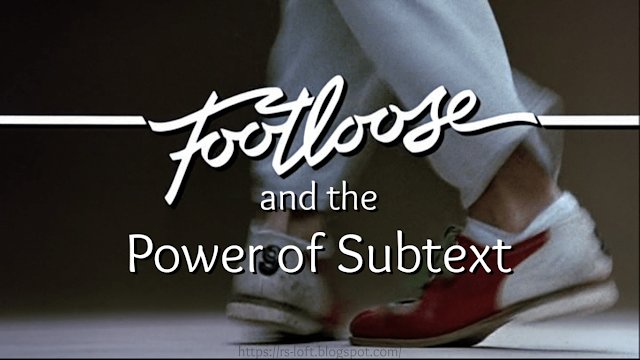Footloose and the Power of Subtext

Back during the summer I saw the movie Footloose for the first time. After viewing it, I can see why it's such a classic movie and one you should probably watch in your lifetime. It's has it's issues in the cleanness department, but other than that it's well done.
One of the things that struck me most about it was the amount of subtext in the movie. There's a lot of unsaid things that you pick up on that are important to the plot. A lot of that is due to excellent acting on the parts of the main characters. Today I'm going to be looking at how Footloose using subtext and how you can use it as well.

Character Subtext
There's a lot of subtext surrounding the different characters. From the Reverend and his rules to protect anyone else from experiencing his pain, to Ren and the reason he's fighting so hard to dance. But I'm going to focus in on a single character- Ariel.
Honestly, she's my least favorite character in the movie. She's a jerk and I don't see why Ren likes her. But there's a lot of subtext around her character, so she's a perfect example.
Ariel's brother died in a car crash after a night of drinking and dancing. Thus, her father and the town council decided to ban dancing, rock music, drinking, smoking, all of it. From there, it kind of evolved until they were even trying to ban books they didn't agree with.
Ariel is the kind of preacher's kid that does the exact opposite of what her father wants because she wants to take control of her own life. From her opening scenes, you see that it goes deeper than that. She risks her life recklessly time and time again. While she never says so, you understand that she's daring death to take her like it took her brother years ago.
How can you use it? The saying "Actions speak louder than words" is old, but it's true. You can use subtext with your characters by having them act certain ways that say more than words ever could. By showing us, rather than telling us (another old saying) what they're truly feeling, readers will connect more with your story and your characters. It makes them feel like they see a part of the character that is rarely seen.
Plot Subtext
There can also subtext on a plot level. In Footloose, this shows itself a lot in the conflict. The conflict on a plot level is between Ren and his desire to dance and Reverend Shaw and his desire to protect his remaining child (and himself). But on an even deeper level, it's an age old clash between man and society.
One of my favorite examples of subtext on a plot level is when the Reverend discovers teachers burning books from the library because they don't agree with it. He stops them and tells them they shouldn't be doing this. But at the same time, he's realizing what he's brought their town to, and he's telling himself just as much as them that they need to stop.
How can you use it? Conflict is full of subtext. Characters act the way they do because of reasons they might not say, but we can understand. The theme of a story is all about subtext. It's about dropping the right clues for readers to be able to pick up on the theme without telling them straight out.
Another interesting thing about Footloose is the fact that it couldn't take place in any other era. The conflict is so closely tied to the time period and the rise of rock and roll that it wouldn't make sense in another era where dancing wasn't considered "evil". (Which why I have no idea why they remade it, and in a more modern time period.)

Have you watched Footloose? What's your favorite thing about subtext? Tell me in the comments.
Suggested Posts:



Honestly your blog is awesome! I love how you break down things and say what you think. Really enjoyed reading! 😊
ReplyDeleteAwe, thank you so much. Comments like this make my day 😊
Delete